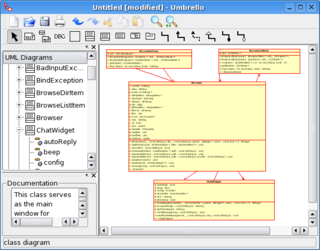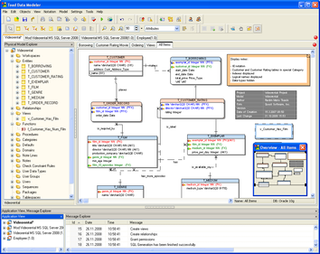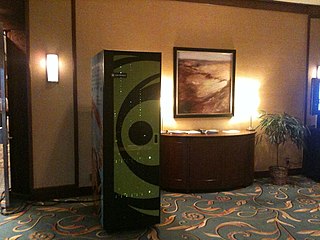Related Research Articles

Informix is a product family within IBM's Information Management division that is centered on several relational database management system (RDBMS) and multi-model database offerings. The Informix products were originally developed by Informix Corporation, whose Informix Software subsidiary was acquired by IBM in 2001.

An object–relational database (ORD), or object–relational database management system (ORDBMS), is a database management system (DBMS) similar to a relational database, but with an object-oriented database model: objects, classes and inheritance are directly supported in database schemas and in the query language. In addition, just as with pure relational systems, it supports extension of the data model with custom data types and methods.

Db2 is a family of data management products, including database servers, developed by IBM. It initially supported the relational model, but was extended to support object–relational features and non-relational structures like JSON and XML. The brand name was originally styled as DB2 until 2017, when it changed to its present form.
Adabas, a contraction of “adaptable database system," is a database package that was developed by Software AG to run on IBM mainframes. It was launched in 1971 as a non-relational database. As of 2019, Adabas is marketed for use on a wider range of platforms, including Linux, Unix, and Windows.

Computer-aided software engineering (CASE) was a domain of software tools used to design and implement applications. CASE tools were similar to and were partly inspired by computer-aided design (CAD) tools used for designing hardware products. CASE tools were intended to help develop high-quality, defect-free, and maintainable software. CASE software was often associated with methods for the development of information systems together with automated tools that could be used in the software development process.
The following tables compare general and technical information for a number of relational database management systems. Please see the individual products' articles for further information. Unless otherwise specified in footnotes, comparisons are based on the stable versions without any add-ons, extensions or external programs.
Apache Derby is a relational database management system (RDBMS) developed by the Apache Software Foundation that can be embedded in Java programs and used for online transaction processing. It has a 3.5 MB disk-space footprint.
IBM InfoSphere DataStage is an ETL tool and part of the IBM Information Platforms Solutions suite and IBM InfoSphere. It uses a graphical notation to construct data integration solutions and is available in various versions such as the Server Edition, the Enterprise Edition, and the MVS Edition. It uses a client-server architecture. The servers can be deployed in both Unix as well as Windows.
Microsoft Identity Integration Server (MIIS) is an identity management (IdM) product offered by Microsoft. It is a service that aggregates identity-related information from multiple data-sources. The goal of MIIS is to provide organizations with a unified view of a user's/resources identity across the heterogeneous enterprise and provide methods to automate routine tasks.
Embedded SQL is a method of combining the computing power of a programming language and the database manipulation capabilities of SQL. Embedded SQL statements are SQL statements written inline with the program source code, of the host language. The embedded SQL statements are parsed by an embedded SQL preprocessor and replaced by host-language calls to a code library. The output from the preprocessor is then compiled by the host compiler. This allows programmers to embed SQL statements in programs written in any number of languages such as C/C++, COBOL and Fortran. This differs from SQL-derived programming languages that don't go through discrete preprocessors, such as PL/SQL and T-SQL.
Information Management Software is one of the brands within IBM Software Group (SWG) division. The major Information Management products include:

Toad Data Modeler is a database design tool allowing users to visually create, maintain, and document new or existing database systems, and to deploy changes to data structures across different platforms. It is used to construct logical and physical data models, compare and synchronize models, generate complex SQL/DDL, create and modify scripts, and reverse and forward engineer databases and data warehouse systems. Toad's data modelling software is used for database design, maintenance and documentation.

IBM Netezza is a subsidiary of American technology company IBM that designs and markets high-performance data warehouse appliances and advanced analytics applications for uses including enterprise data warehousing, business intelligence, predictive analytics and business continuity planning.
pureXML is the native XML storage feature in the IBM Db2 data server. pureXML provides query languages, storage technologies, indexing technologies, and other features to support XML data. The word pure in pureXML was chosen to indicate that Db2 natively stores and natively processes XML data in its inherent hierarchical structure, as opposed to treating XML data as plain text or converting it into a relational format.
Composite Software, Inc. was previously a privately held data virtualization software company based in San Mateo, California. Composite Software was founded in October 2001 by Michael R. Abbott. In 2003, former Active Software founder and webMethods CTO, Jim Green joined Composite Software as CEO. On July 30, 2013, Composite Software was acquired by Cisco Systems for approximately US $180 million. Then on October 5, 2017 TIBCO purchased what was Composite Software from Cisco.
In-database processing, sometimes referred to as in-database analytics, refers to the integration of data analytics into data warehousing functionality. Today, many large databases, such as those used for credit card fraud detection and investment bank risk management, use this technology because it provides significant performance improvements over traditional methods.
Informix Corporation was a software company located in Menlo Park, California. It was a developer of relational database software for computers using the Unix, Microsoft Windows, and Apple Macintosh operating systems.
Rocket U2 is a suite of database management (DBMS) and supporting software now owned by Rocket Software. It includes two MultiValue database platforms: UniData and UniVerse. Both of these products are operating environments which run on current Unix, Linux and Windows operating systems. They are both derivatives of the Pick operating system. The family also includes developer and web-enabling technologies including SB/XA, U2 Web Development Environment (WebDE), UniObjects connectivity API and wIntegrate terminal emulation software.

DBeaver is a SQL client software application and a database administration tool. For relational databases it uses the JDBC application programming interface (API) to interact with databases via a JDBC driver. For other databases (NoSQL) it uses proprietary database drivers. It provides an editor that supports code completion and syntax highlighting. It provides a plug-in architecture that allows users to modify much of the application's behavior to provide database-specific functionality or features that are database-independent. This is a desktop application written in Java and based on Eclipse platform.